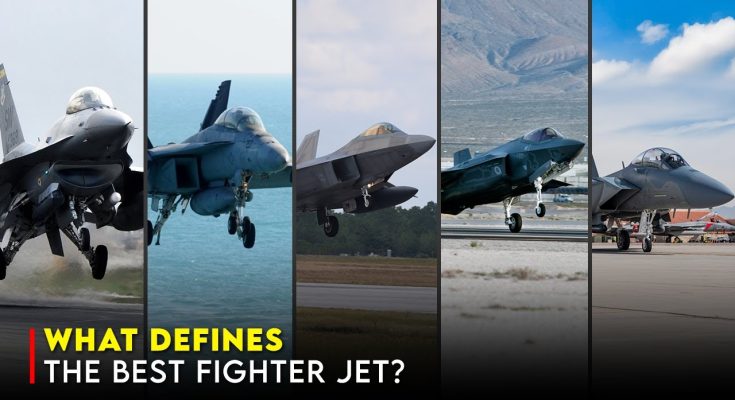As we move into 2025, the United States continues to lead the world in developing and maintaining cutting-edge fighter jets. These aircraft represent the forefront of air combat technology, blending stealth, agility, and advanced avionics. Here are some of the top U.S. military fighter jets to watch in 2025:
1. Lockheed Martin F-35 Lightning II
The F-35 Lightning II remains one of the most advanced fighter jets in the world. It comes in three variants: F-35A (CTOL, conventional takeoff and landing), F-35B (STOVL, short takeoff and vertical landing), and F-35C (carrier-based for the U.S. Navy).
- Key Features:
- Stealth Technology: Its low radar profile allows it to operate in contested environments without detection.
- Multirole Capability: Designed for air superiority, ground attack, and intelligence gathering, it is a versatile platform for modern warfare.
- Sensor Fusion: Its advanced avionics, including radar, infrared sensors, and electronic warfare systems, provide real-time situational awareness to the pilot.
The F-35 is the backbone of the U.S. military’s future air combat operations, providing unmatched flexibility and capability.
2. Lockheed Martin F-22 Raptor
The F-22 Raptor is often regarded as the most advanced air superiority fighter in the world. Although production ceased in 2009, it continues to serve as the U.S. Air Force’s premier air-to-air combat platform.
- Key Features:
- Supercruise: The ability to fly at supersonic speeds without using afterburners gives it a significant edge over adversaries.
- Stealth and Agility: Combined with its advanced avionics, the F-22 is highly maneuverable and nearly invisible to radar.
- Air Superiority: The F-22 excels in controlling the skies, making it an essential asset in any conflict involving air dominance.
Despite being surpassed by the F-35 in terms of multirole capability, the F-22 is unmatched in air-to-air combat.
3. Boeing F-15EX Eagle II
The F-15EX Eagle II is the latest variant of the F-15 series, known for its exceptional range and payload capacity. It is designed to complement the F-35 in the U.S. Air Force’s fleet.
- Key Features:
- Enhanced Avionics: The F-15EX features state-of-the-art radar and electronic warfare systems.
- Heavy Payload: It can carry a large variety of weapons, from air-to-air missiles to precision-guided bombs.
- Low-Cost, High-Impact: As a cost-effective solution, the F-15EX provides significant combat power at a fraction of the cost of newer fighters like the F-35.
The F-15EX will play a crucial role in maintaining U.S. air superiority, especially in less contested environments where cost-effectiveness is key.
4. Boeing F/A-18E/F Super Hornet
Serving as the U.S. Navy’s primary carrier-based fighter, the F/A-18E/F Super Hornet is a versatile multirole aircraft that has proven itself in numerous combat scenarios.
- Key Features:
- Multirole Capability: The Super Hornet can perform a wide range of tasks, from air-to-air combat to strike missions and reconnaissance.
- Carrier Operations: Designed for tough carrier operations, the Super Hornet is a vital part of the U.S. Navy’s ability to project power worldwide.
- Reliability: Known for its durability and ability to operate in challenging conditions, the Super Hornet remains a staple of the Navy’s air combat strategy.
As the Navy transitions to more advanced aircraft like the F-35C, the Super Hornet remains an essential part of U.S. maritime defense.
5. McDonnell Douglas F-15E Strike Eagle
An upgraded version of the F-15, the F-15E Strike Eagle is designed for multirole strike missions. Its focus is on delivering precision strikes against ground targets, especially in contested and high-threat environments.
- Key Features:
- Advanced Avionics: The F-15E features sophisticated targeting systems, allowing it to carry out precision strikes day or night, in all weather conditions.
- Heavy Payload: With the capacity to carry large payloads, including air-to-ground missiles and bombs, the F-15E is a formidable platform for deep strike missions.
- Range and Endurance: With its long-range capabilities, the F-15E can perform extended missions without needing to refuel.
While the F-35 has taken over as the primary multirole fighter, the F-15E remains crucial for certain tactical missions due to its strike capability.
6. Next Generation Air Dominance (NGAD)
While still in development, the Next Generation Air Dominance (NGAD) program promises to produce the sixth-generation fighter jet that will eventually replace the F-22 and complement the F-35. Details on the NGAD are classified, but reports suggest it will feature advanced capabilities like:
- Artificial Intelligence: AI-assisted piloting and decision-making processes.
- Hypersonic Weapons: Capable of reaching speeds greater than Mach 5, hypersonic missiles will revolutionize combat operations.
- Enhanced Stealth: With even more advanced stealth technologies, the NGAD will make detection nearly impossible.
The NGAD will likely shape the future of aerial combat for decades to come, maintaining U.S. dominance in the skies.
Conclusion
The top U.S. military fighter jets in 2025 are a blend of cutting-edge technology, proven performance, and strategic versatility. From the versatile F-35 to the future NGAD, these jets are designed to meet the complex demands of modern warfare, ensuring the United States maintains its air superiority in the years to come.



